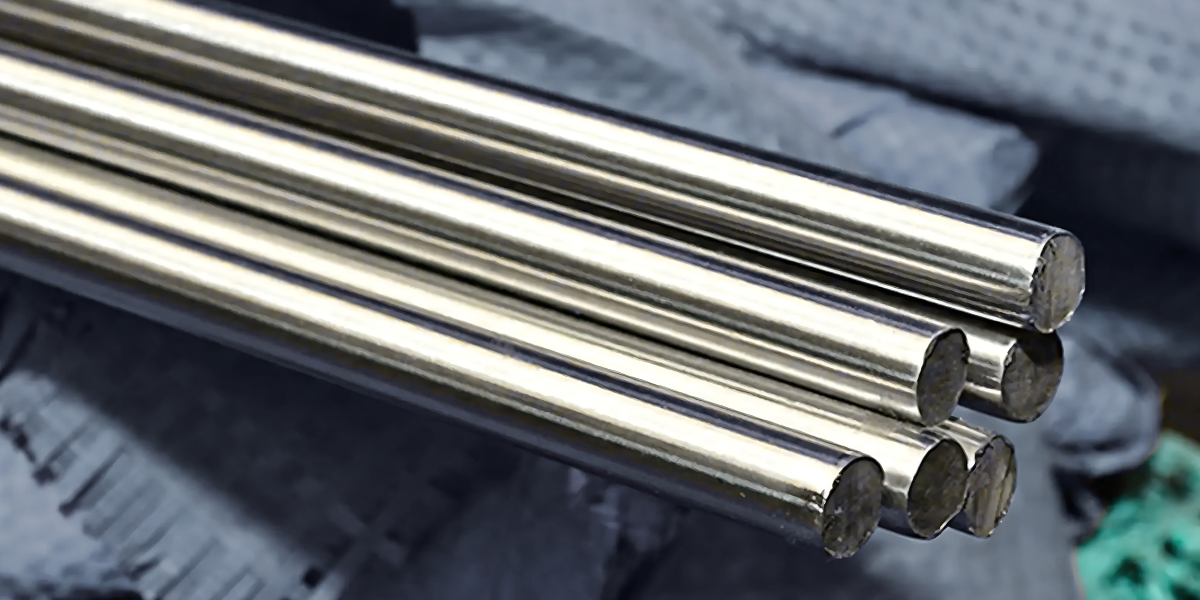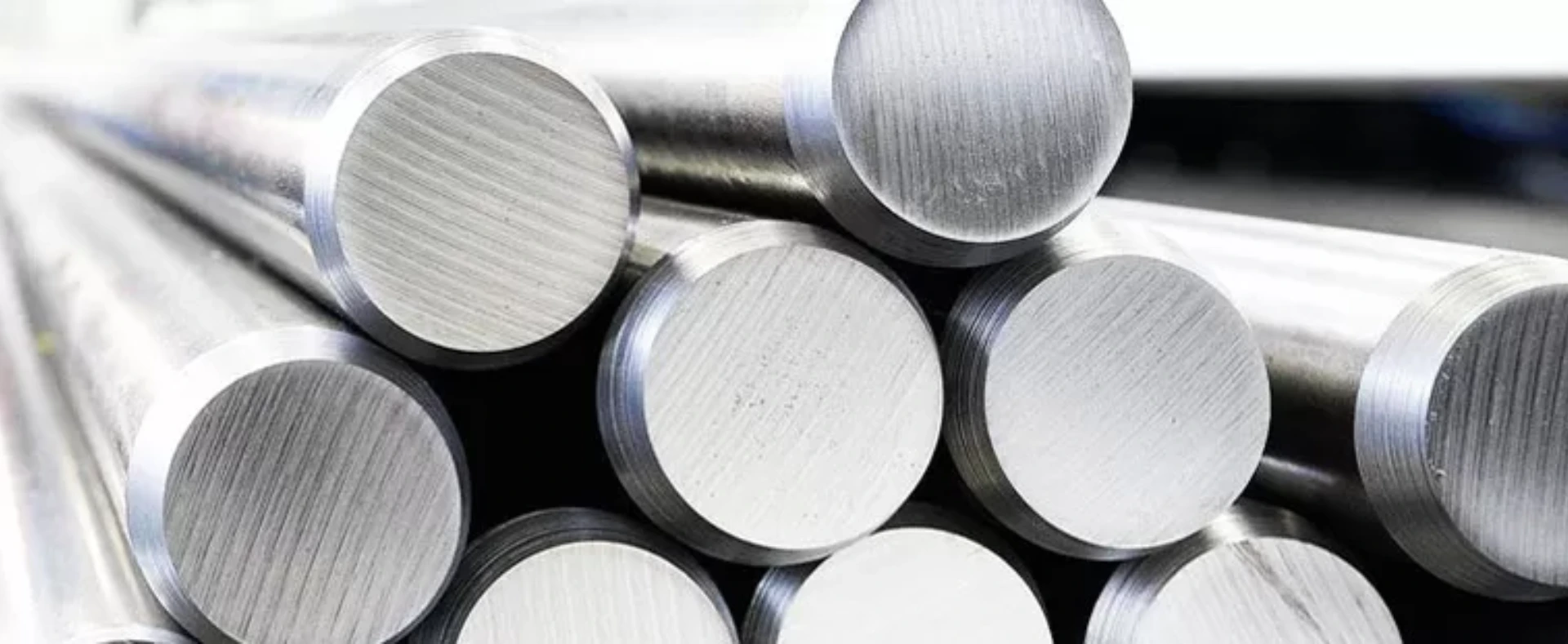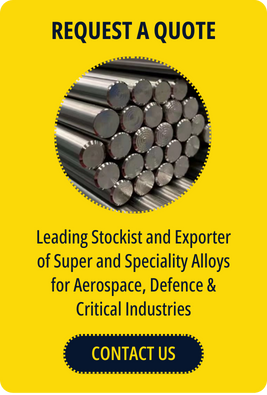Denounce with righteous indignation and dislike men who are beguiled and demoralized by the charms pleasure moment so blinded desire that they cannot foresee the pain and trouble.
Read MoreHaynes 25 (L605) Supplier and Stockist in India
High Quality Haynes 25 (L605) Stockist in Mumbai, India. Supplier of UNS R30605 Sheets, ASTM B408 Haynes 25 Round Bars Stockist, DIN 2.4964 Plates Distributor, Renowned Aerospace-Grade Haynes 25 / L605 Supplier & Exporter.
L605 (Haynes 25) is a cobalt-based superalloy valued for its exceptional high-temperature strength, excellent oxidation resistance, and superior wear and galling resistance. These properties make it a go-to material for aerospace and defense applications where components must perform reliably under extreme thermal and mechanical stress. Commonly used in turbine engine parts, combustion chambers, fasteners, and other critical aerospace hardware, Haynes 25/L605 ensures durability and long service life in demanding environments. Bhansali AeroAlloys supplies this alloy in the form of round bars, sheets, plates, and custom-engineered shapes to meet the precise needs of aerospace and defense manufacturers.

Haynes 25 (L605) Stockist
At Bhansali AeroAlloys, we are committed to delivering high-quality Haynes 25/L605 that meets stringent mechanical and chemical standards for aerospace-grade materials. Our expertise in specialty alloys and dedication to consistent quality make us a trusted partner for mission-critical defense and aerospace projects. For inquiries or to request a quote for Haynes 25/L605 in your required form, reach out to us at sales@bhansaliaeroalloys.com and secure reliable, high-performance alloys tailored to your engineering requirements.
Type Analysis
| Element | Min | Max |
|---|---|---|
| Carbon | 0.05 | 0.15 |
| Nickel | 9.00 | 11.0 |
| Iron | -- | 3.00 |
| Silicon | -- | 1.00 |
| Manganese | 1.00 | 2.00 |
| Cobalt | Balance | -- |
| Chromium | 19.0 | 21.0 |
| Tungsten | 14.0 | 16.0 |
| Phosphorus | -- | 0.03 |
| Sulfur | -- | 0.03 |
Characteristics
- Haynes 25 (L605) is a cobalt-based alloy offering good formability and excellent high-temperature strength.
- At 1800°F, Haynes 25 sheet exhibits a 100-hour stress-rupture strength of 7000 psi.
- The alloy provides resistance to oxidation and carburization up to 1900°F.
Applications
- Haynes 25 has proven reliable in jet engine components such as turbine blades, combustion chambers, afterburner parts, and turbine rings.
- The alloy L605 is also widely used in industrial furnace applications, including furnace muffles and liners for critical high-temperature kiln areas.
Corrosion Resistance
- Haynes 25 (L605) demonstrates excellent resistance to hot corrosive atmospheres commonly encountered in jet engine operations.
- It offers good oxidation resistance for intermittent service up to 1600°F and continuous service up to 2000°F.
- The alloy is highly resistant to scaling and oxidation at elevated temperatures, with strong performance under extreme oxidizing conditions.
- It provides excellent resistance to chemical oxidizing agents, along with outstanding resistance to hydrochloric and nitric acids under certain concentrations and temperatures.
- Resistance to salt spray corrosion is also very good.
Heat Treatment
- Solution Heat Treated for Best Properties:
- Most wrought products are supplied in the solution heat-treated condition for optimum properties.
- Typical solution heat treatment is performed at 2150–2250°F, followed by rapid air cooling or water quenching.
- Sheet ≤ 0.025″: treated at 2150°F, rapid air cooled or water quenched.
- Sheet ≥ 0.026″: treated at 2200°F, rapid air cooled or water quenched.
- Plate: treated at 2200°F, water quenched.
- Bar: treated at 2250°F, water quenched.
- Room and Elevated Temperature Properties Enhanced by Cold Work and Aging:
- Cold working and aging enhance both room and elevated temperature tensile strength of Haynes 25 sheet.
- Moderate cold work increases creep strength up to 1800°F and stress rupture strength up to 1500°F.
- Aging provides no significant improvement in properties.
- Strain aging at 700–1100°F improves creep and rupture strength below 1300°F.
Physical Properties
| Physical Properties | °F | British Units | °C | Metric Units |
|---|---|---|---|---|
| Density | 72 | 0.330 lb./cu. in. | 22 | 9.13 g/cu. cm. |
| Melting Range | 2425–2570 | — | 1329–1410 | — |
| Electrical Resistivity | 75 | 34.9 microhm-in. | 24 | 89 microhm-cm |
| 460 | 38.1 microhm-in. | 238 | 97 microhm-cm | |
| 840 | 39.2 microhm-in. | 449 | 99 microhm-cm | |
| 1200 | 41.8 microhm-in. | 649 | 106 microhm-cm | |
| 1360 | 42.2 microhm-in. | 727 | 107 microhm-cm | |
| 1500 | 42.4 microhm-in. | 816 | 108 microhm-cm | |
| 1740 | 38.0 microhm-in. | 949 | 97 microhm-cm | |
| 1830 | 37.5 microhm-in. | 999 | 95 microhm-cm | |
| 1980 | 39.3 microhm-in. | 1082 | 100 microhm-cm | |
| Mean Coefficient of Thermal Expansion | 70–200 | 6.8 micron/in./°F | 21–93 | 12.3 microns/m·°C |
| 70–400 | 7.2 micron/in./°F | 21–204 | 12.9 microns/m·°C | |
| 70–600 | 7.6 micron/in./°F | 21–316 | 13.5 microns/m·°C | |
| 70–800 | 7.8 micron/in./°F | 21–427 | 14.0 microns/m·°C | |
| 70–1000 | 8.0 micron/in./°F | 21–538 | 14.5 microns/m·°C | |
| 70–1200 | 8.2 micron/in./°F | 21–649 | 14.8 microns/m·°C | |
| 70–1400 | 8.6 micron/in./°F | 21–760 | 15.5 microns/m·°C | |
| 70–1600 | 9.1 micron/in./°F | 21–871 | 16.2 microns/m·°C | |
| 70–1800 | 9.4 micron/in./°F | 21–982 | 17.0 microns/m·°C | |
| 70–2000 | 9.8** micron/in./°F | 21–1093 | 17.7 microns/m·°C | |
| Thermal Conductivity | 70 | 65** Btu-in/ft²-hr-°F | 20 | 0.098 watt-cm/cm²-°C |
| 100 | 67** Btu-in/ft²-hr-°F | 100 | 0.112 watt-cm/cm²-°C | |
| 300 | 82 Btu-in/ft²-hr-°F | 200 | 0.130 watt-cm/cm²-°C | |
| 500 | 97 Btu-in/ft²-hr-°F | 300 | 0.147 watt-cm/cm²-°C | |
| 700 | 112 Btu-in/ft²-hr-°F | 400 | 0.166 watt-cm/cm²-°C | |
| 900 | 127 Btu-in/ft²-hr-°F | 500 | 0.185 watt-cm/cm²-°C | |
| 1100 | 142 Btu-in/ft²-hr-°F | 600 | 0.204 watt-cm/cm²-°C | |
| 1300 | 157 Btu-in/ft²-hr-°F | 700 | 0.224 watt-cm/cm²-°C | |
| 1500 | 172 Btu-in/ft²-hr-°F | 800 | 0.244 watt-cm/cm²-°C | |
| 1700 | 191 Btu-in/ft²-hr-°F | 900 | 0.265 watt-cm/cm²-°C | |
| Specific Heat (calculated) | 80–212 | 0.092 Btu/lb-°F | 28–100 | 0.092 cal/g-°C |
| Magnetic Permeability (Room Temperature) | <1.0 at 116 oersteds | |||
Dynamic Modulus of Elasticity
| Form | Condition | Test Temperature °F | Dynamic Modulus of Elasticity, psi x 106 |
|---|---|---|---|
| Sheet | Solution heat treated | 77 | 32.6 |
| 212 | 32.2 | ||
| 392 | 31.0 | ||
| 572 | 29.6 | ||
| 752 | 28.6 | ||
| 932 | 27.3 | ||
| 1112 | 26.3 | ||
| 1292 | 25.2 | ||
| 1472 | 23.7 | ||
| 1652 | 22.4 | ||
| 1832 | 21.2 |
Mechanical Properties
| Form | Condition | Test Temperature °F | Ultimate Tensile Strength, ksi | Yield Strength at 0.2% offset, ksi | Elongation in 2", % |
|---|---|---|---|---|---|
| Sheet, 0.044-0.056" | Solution heat treated | Room | 144.5* | 66.7* | 59* |
| Sheet, 0.060-0.083" | Room | 139.1* | 62.2* | 62* | |
| Sheet, 0.094-0.130" | Room | 140.6* | 64.6* | 62* | |
| 0.141 to Plate, 0.313" | Room | 136.7* | 63.0* | 63* | |
| Plate, 0.375-0.625" | Room | 142.6* | 68.3* | 56* | |
| Plate, 0.750" and up | Room | 138.7* | 65.8* | 60* |
Typical Short-Time Tensile Data
| Form | Condition | Test Temperature °F | Ultimate Tensile Strength, ksi | Yield Strength at 0.2% offset, psi | Elongation in 2", % |
|---|---|---|---|---|---|
| Sheet, 0.109" thick | Solution heat treated | Room | 135.0 | 65.0 | 60 |
| 600 | 120.4 | 44.3 | 80 | ||
| 1000 | 106.2 | 39.0 | 72 | ||
| 1200 | 103.0 | 35.4 | 35 | ||
| 1400 | 84.5 | 35.1 | 28 | ||
| 1600 | 46.6 | 34.5 | 30 | ||
| 1800 | 33.5 | 18.2 | 40 | ||
| 2000 | 19.6 | 12.0 | 34 | ||
| 2200 | 11.1 | 4.70 | 38 | ||
| Plate | Solution heat treated | -321 | 207.2 | -- | 37 |
| -108 | 171.2 | -- | 50 | ||
| 75 | 140.7 | -- | 58 | ||
| Bar, 1" Diameter | Solution heat treated | Room | 150.0 | 70.0 | 65* |
| 1000 | 109.0 | -- | 71* | ||
| 1200 | 97.0 | -- | 37* | ||
| 1350 | 74.1 | -- | 36* | ||
| 1500 | 65.7 | -- | 24* | ||
| 1650 | 42.7 | -- | 24* | ||
| 1800 | 32.9 | -- | 21* | ||
| Bar, 2.75-3.00" Dia. | Solution heat treated | 600 | 117.1 | 41.3 | 87 |
Average Rupture Data
| Form | Condition | Test Temperature °F | Average Initial Stress (ksi) for Rupture at: | ||
|---|---|---|---|---|---|
| 10 hrs | 100 hrs | 1000 hrs | |||
| Sheet | Solution heat treated | 1500 | 30,000 | 22,000 | 17,500 |
| 1600 | 23,000 | 15,000 | 10,500 | ||
| 1700 | 17,500 | 10,500 | 6,400 | ||
| 1800 | 12,000 | 7,000 | 3,600 | ||
| 2000 | 5,600 | 2,800 | -- | ||
| Bar | Solution heat treated | 1350 | 42,500 | 36,500 | 30,300 |
| 1500 | 30,000 | 22,000 | 17,000 | ||
| 1600 | 23,000 | 16,500 | 12,000 | ||
| 1700 | 17,000 | 12,000 | 8,400 | ||
| 1800 | 11,500 | 7,500 | 5,000 | ||
| 2000 | 6,000 | 3,300 | 1,800 | ||
| 2100 | 3,600 | 1,700 | -- | ||
Workability
- Machinability:
- Haynes 25 (L605) can be machined using conventional techniques.
- High-speed steel or carbide tools with rigid machine setups are recommended due to the material’s hardness.
- It is more difficult to machine than austenitic stainless steels (e.g., Types 302, 304, 321, 347).
- Lower feeds, speeds, and depths of cut are generally suggested.
- High work hardening rate, heat generation during cutting, and high shear strength make machining challenging.
- Welding:
- Can be welded using shielded metal-arc, gas tungsten-arc (TIG), and gas metal-arc (MIG) methods.
- Submerged-arc welding is not recommended due to high heat input and slow cooling, which can reduce weld ductility and increase cracking risk.
- Cleaning:
- Thoroughly clean the joint surface and surrounding area down to bright metal before welding.
- Remove all grease, oil, crayon marks, and other contaminants by scrubbing with trichlorethylene or a suitable solvent.
- Wipe the surface clean before beginning welding.
Global Export Destinations for Our Haynes 25/L605
Domestic Cities Where We Supply Haynes 25/L605
We supply Haynes 25/L605 to cities including Mumbai, Delhi, Kolkata, Chennai, Bengaluru, Hyderabad, Ahmedabad, Pune, Surat, Jaipur, Kanpur, Lucknow, Nagpur, Ghaziabad, Indore, Coimbatore, Kochi, Patna, Kozhikode, Bhopal, Thrissur, Vadodara, Agra, Malappuram, Thiruvananthapuram, Kannur, Ludhiana, Nashik, Vijayawada, Madurai, Varanasi, Meerut, Faridabad, Rajkot, Jamshedpur, Srinagar, Jabalpur, Asansol, Vasai-Virar City, Allahabad, Dhanbad, Aurangabad, Amritsar, Jodhpur, Ranchi, Raipur, Kollam, Gwalior, Durg-Bhilainagar, Chandigarh, and Tiruchirappalli.




